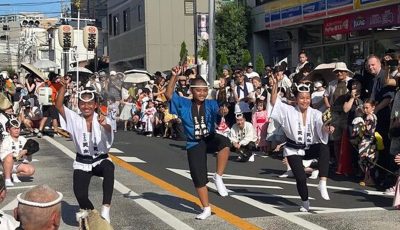Quietly, Guam slated to become a massive new US military base

The Ashland LSD, a dock landing ship, sit in the newly refurbished Victor Wharf on Naval base Guam on Aug. 5, 2015. (Mcclatchy DC/TNS)
HAGATNA, Guam—Thousands of Marines will land on this island sometime in the next few years, and their first steps will fall on a sturdy-as-granite pier in a sheltered Pacific harbor newly rebuilt to carry wave after wave of tank-driving troops.
“We’re ready for them,” said Cmdr. David Ellis, the executive officer at a Navy base that’s been swelling with military construction projects to prepare for the new troops.
What’s less certain is what the Marines will do when they get here.
This U.S. territory in the Western Pacific, long a way station for passing jets and submarines, is about to become a hub for a force of 4,800 Marines who’ll be charged with readying for war and disasters in East Asia.
The trouble is the Pentagon has not yet persuaded two nearby islands to accept a proposal that would give the Marines a space to train during their Pacific patrols. And some are suggesting, subtly, that it may be difficult to station so many military service members on Guam if they cannot train nearby.
On one island, Tinian, a Marine plan to practice ground maneuvers is setting off fears that the sounds of mortars and rocket blasts will quash a budding Chinese-backed tourism-casino industry. The companies behind the casinos have been hinting they’d pull out if the Marine proposal becomes a reality.
On the other, Pagan, a proposal to make a massive international military training zone on an island known for its namesake volcano is hitting a nerve among people who dream of returning to it three decades after an eruption forced their evacuation.
Both islands are governed by the Commonwealth of the Northern Mariana Islands, a separate U.S. territory that revealed its concerns when it hired an attorney known for fighting Pentagon plans in the Pacific.
“Having a place to fire cannons and practice obviously is essential, but this just isn’t the right place,” said Nick Yost, the San Francisco attorney hired by the Commonwealth.
It’s another clash in the Defense Department’s campaign to find new places for the U.S. and its allies to practice military exercises near the scene of brewing conflicts in East Asia.
They’re drawn to Guam and the Mariana Islands because they’re American territories that would offer reliable space without worries of a foreign government suddenly revoking a partnership with the U.S. military. That’s been a concern for military planners since the Philippine government booted the Navy from its base at Subic Bay in 1992.
In Guam and the Marianas, the Defense Department wants to create a space for large-scale exercises involving every branch of the American military and its Pacific allies. It would be adjacent to the Navy’s underwater training range in the Mariana trench, providing a rare location for the military to integrate sea and land warfare.
It also would help the military draw down its ranks on the Japanese island of Okinawa, where a dense concentration of Marine bases has motivated popular public protests for decades.
Japan, which hosts most of the troops who would be sent to Guam, is paying for more than a third of the estimated $8.7 billion cost of creating the new Marine facilities. Japan likely would participate in joint exercises if the training grounds are built, and Marines on Guam would be expected to respond to a disaster in Japan, 1,400 miles to the west.
“It’s location, location, location. We’re U.S. sovereign soil and we’re basically in the same time zone as Japan. The next closest U.S. soil is a seven-hour flight to Hawaii,” said Guam Gov. Eddie Calvo, one of the boosters behind the military buildup in Guam and the neighboring Northern Mariana Islands.
But the plan carries a too heavy footprint for some islanders, who want to see a smaller military presence on territories the U.S. has held since it seized them from Japan in World War II.
The military controls more than a quarter of the land on Guam’s 212 square miles. The territory contains a sprawling Navy base, with special operations teams and docks for several submarines, as well as an Air Force base that houses a bomber group.
Adding the new training areas would mean that three of the 15 islands in the Commonwealth of the Northern Mariana Islands north of Guam would be used mostly for the military. The U.S. already uses one for aircraft bombing practice.
“We’re going to become this island with only one purpose, and that will be for the military,” said Victoria Lola-Guerrero, 33, who has been protesting the military plans for the past five years.
Her activism under the banner of a group called We Are Guahan compelled the Pentagon to scale down its original plan for Guam, one that would have sent far more Marines to the island on a much faster timeline.
It also would have taken privately owned land near Pagat, an ancient ocean-side village cherished by locals, to create a firing range for Marine machine guns.
At that time, the Pentagon wanted to quickly halve the 19,000 Marines stationed on Okinawa. It would have sent some 8,600 troops to Guam with an additional 9,000 military family members, potentially overwhelming a territory that has just 160,000 residents.
We Are Guahan worked with attorney Yost to file a lawsuit against the plan, forcing the Pentagon to look at other options. The result was a blueprint the Navy approved in August, calling for fewer than 5,000 Marines on Guam and backing off the use of Pagat as a firing range.
It was a win for the activists, but some in the group want to go further. They feel as if their preference—no new Marines on Guam—was never considered.
“Is it a better plan than the first one? Yes,” said Guam attorney Leevin Camacho, 37, who worked with Lola-Guerrero at We Are Guahan. “Is it a good plan? That’s the operative question. It’s almost like old-school negotiating where you offer something so unreasonable that anything after sounds like, ‘We’re accommodating you.’”
With the plans for the Guam buildup set, activists now are pushing back against the military’s proposal for the islands of Tinian and Pagan. Natives on Guam and the Marianas have a common heritage as descendants of an indigenous people called Chamorros, making their efforts a shared cause across the island chain.
Tininan, where Chinese companies claim they want to build three multimillion-dollar casinos, contains the runway the Air Force used to strike Hiroshima with an atomic bomb in August 1945. The military has a lease to use much of the island, but locals describe the current activities as “unobtrusive.”
The island has about 3,000 residents who’ve been raising concerns that increased military training could curtail investment or restrict the small planes they rely on for travel.
“Tinian is incredibly small,” said Gov. Eloy Inos, the commonwealth’s elected leader. “In all honesty, some of the specific live fire training activities the Marines are proposing for Tinian just do not seem appropriate.”
The would-be casino investors have been making their views clear, too. Their moves are the subject of gossip throughout the islands, because no one can tell how serious they are about a turning a remote island in the Western Pacific into a premier resort.
One of the casino proposals comes from a Chinese company called Alter City Group, which has pledged about $500 million in investment on Tinian.
The military proposal would “significantly alter the island as we know it in dramatically irreparable ways and readily acknowledges that it will impact the island for future generations,” the company wrote in response to the Marine plan. “The military has suggested activities which adversely impact the island of Tinian, its residents and adjacent operators like ACG. The benefits from the military with the (proposal) are minimal, but the burdens are significant and unsustainable.”
Pagan, known for its active volcano, hasn’t had much of a population since Mount Pagan’s eruptions drove away residents in the early 1980s. Yet it’s considered a homeland for many Chamorro descendants who want to return there.
Gov. Inos regularly hears from residents who want to stake claims on the island despite the volcano’s continuing eruptions.
The island also has inspired its few visitors to speak out against a proposal that would turn it into a military training ground for up to four months of the year.
“We all came back feeling ‘let’s put our bodies in front of the bullets,’” said Michael Hadfield, a professor emeritus at the University of Hawaii who participated in a wildlife survey on Pagan in 2010.
He and his colleagues were taken by the island’s beauty. They grew concerned that it would meet a fate similar to the Hawaiian island of Kahoolawe, the former Navy bombing range that remains mostly uninhabited decades after the military ceased using it for training.
“If they station 2,000 Marines on it and blast the hell out of it, what we’re talking about is the destruction of the place. If they do it, it’s gone,” he said.
Military leaders are being diplomatic about their plans, inviting feedback to make a stronger proposal. They twice extended a public comment period on the first draft this summer. The Marines received 9,000 public comments about the training plan and have agreed to conduct a further study on possible impacts to coral off of Tinian and Pagan. An updated draft is expected next year.
The alternatives for Pacific training likely would be in other countries, such as Australia or the Philippines. Gov. Inos wants the military to look hard at those sites before settling on Tinian and Pagan.
“There are training capabilities that the Marines need that cannot be provided on Guam. If it fails to proceed, it’s to the deficiency of the Marines,” said Navy Cmdr. Dan Schaan, who managed the final plans for the Guam buildup.
On Guam, some political and business leaders are concerned that the military will retract its investment in their territory if it can’t train on Tinian or Pagan.
They’re hoping to build on the first wave of Marines heading to Guam, aiming to draw in more troops and military families over time.
“This is so big that people are going to have to learn to get along,” said John Thomas Brown, the director of a business-backed group called the Guam-U.S. Security Alliance, which favors the military buildup. “If they can’t get the Marianas, they aren’t going to come. It can be done. It should be done. Time is wasting.”



























